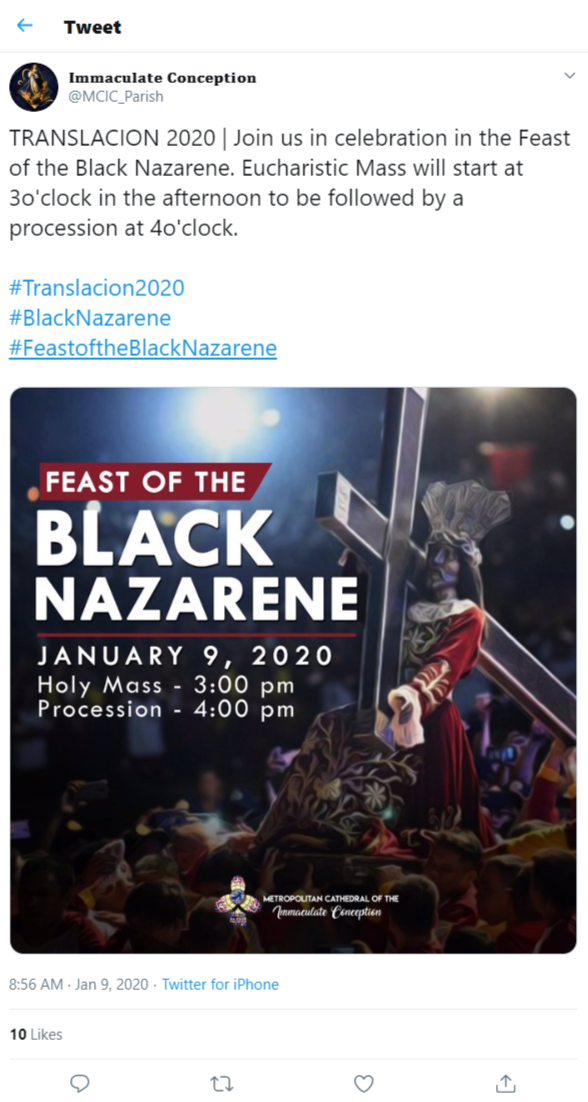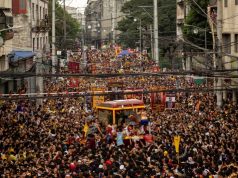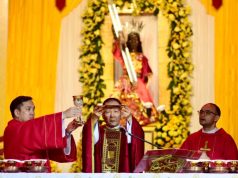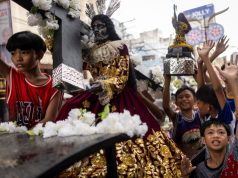Some Filipinos still confuse the Spanish term for translation “translacion” with Traslación, the long procession during the Feast of the Black Nazarene despite celebrating it for 20 years now.
As the image of the Black Nazarene made its way from the Quirino Grandstand to the Quiapo Church, the hashtag #traslacion2020 trended on social media with photos and videos of the ongoing religious event.
However, some users still used “translacion” instead of Traslación, including some local media outfits and parishes in their posts.
Online Spanish translators would tell you that “translacion” directly refers to “translation” in English. Traslación, meanwhile, has a more historical and religious origin.
Msgr. Jose Clemente Ignacio, rector of the Minor Basilica of the Black Nazarene, explained that the Traslación is basically the transfer of the image of the Black Nazarene, which had been in the Philippines for over 400 years.
“In a way it is imitating the Calvary experience: the sacrifice and suffering that our Lord endured for our salvation like when Jesus was walking barefoot, carrying the cross to Mount Calvary,” Ignacio told the Catholic News Agency.
It also commemorates the transfer of the image from Luneta, its first location, to the basilica at Quiapo, Manila also known as the Quiapo Church, back in 1868. It was the time when people started celebrating the feast on January 9.
“The barefoot procession of an almost 4.3-mile journey starts from the Quirino Grandstand at Luneta and snakes its way towards the narrow streets. Passing through the city’s winding roads, after 19 hours of spiritual euphoria, the procession eventually reaches Quiapo at the Basilica Minore de Nazareno. The devotees flood by to touch the image and throw cloths to touch the image, before receiving the cloths back,” Ignacio explained.
For this year’s commemoration, the Department of Interior and Local Government said that 13,624 police officers were deployed to ensure the safety of the devotees and the peace of the whole event.
Interior Secretary Eduardo Año also said that the route this year is shorter than usual.
“Despite it taking a shorter route than usual, we guarantee the public and the devotees of the Black Nazarene that all bases are covered and all security measures are in place for the Traslación 2020,” Año said.
The new route follows the Translation crossing the Pasig River through the Ayala bridge, and then turning left onto the Carlos Palanca Street.
Brief history of Traslacion and the devotion to the image
The image of the Black Nazarene was said to be carved in Mexico during the 16th Century.
In 1606, a group of Augustinian Recollect missionaries brought the artifact from Mexico to the Philippines.
It was first enshrined in St. John the Baptist Church at Luneta and then transferred to a bigger church nearby. In 1767, it was finally transferred to Quiapo Church, whose patron saint also happened to be St. John the Baptist.
This “solemn transfer” of the image eventually became the annual January 9 Traslación procession.
Because of the long route from Quiapo to Luneta, the Traslación lasted at least 20 hours.













